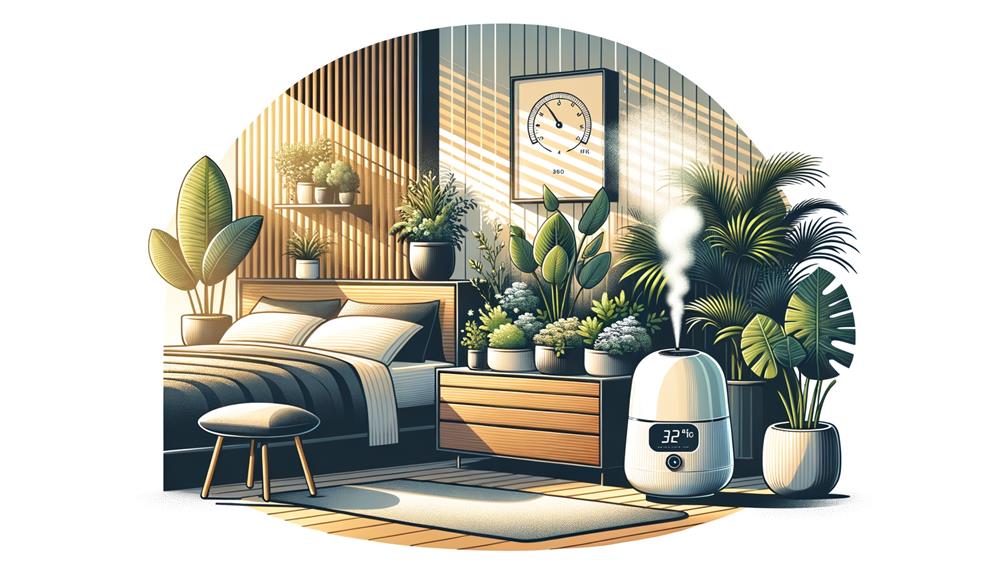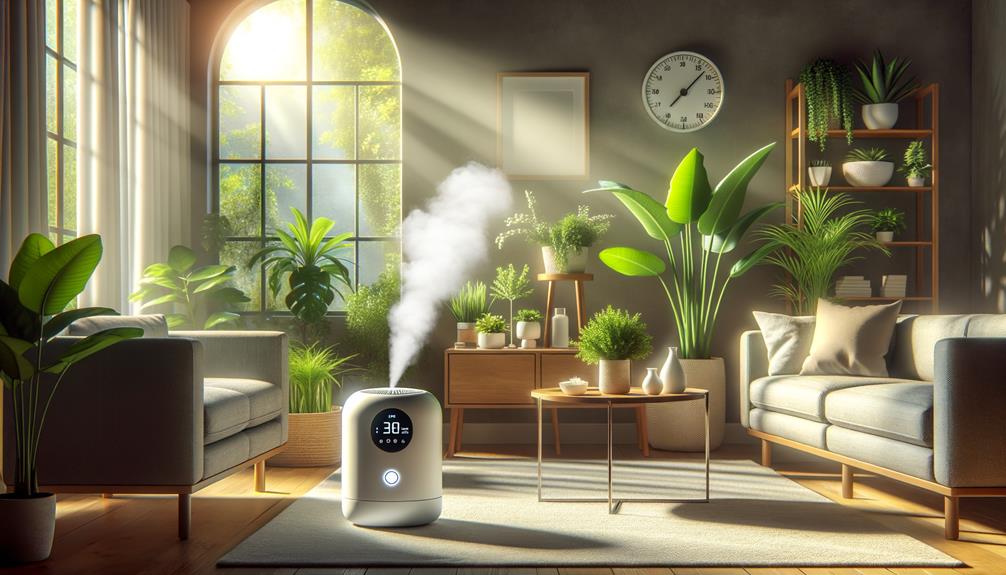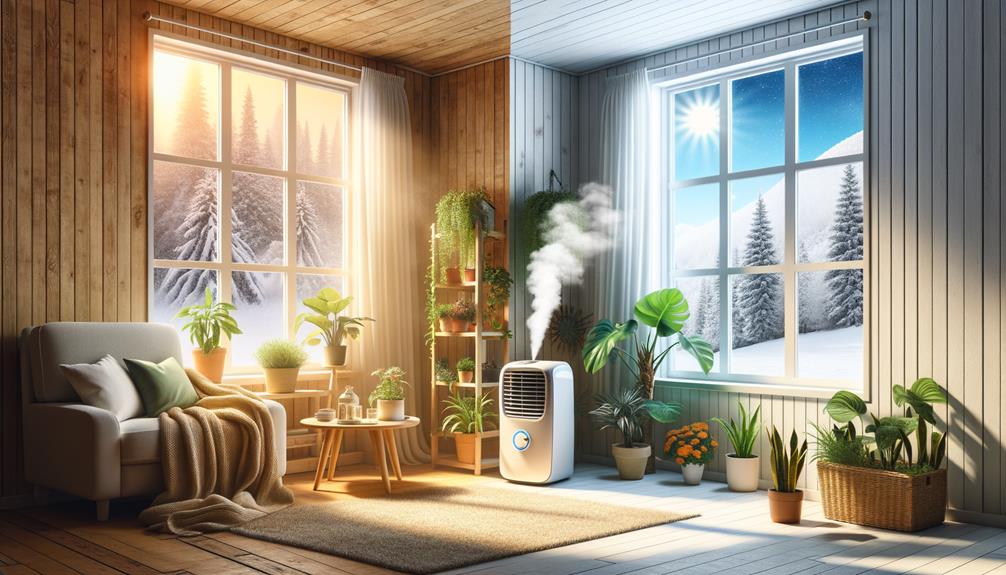Maintaining a comfortable humidity level in your home is crucial for both your health and overall wellbeing. When humidity is too high, it can lead to mold growth and dust mites, while low humidity can cause dry skin and respiratory issues.
For a restful night's sleep, it's best to keep your bedroom humidity between 30% and 50%, with a temperature of around 65 degrees Fahrenheit. There are several effective ways to control humidity, including dehumidifiers, humidistats, and HVAC systems. It's essential to adjust these levels seasonally to avoid flu in dry winters and allergens in humid summers.
Proper humidity management not only improves comfort but also helps prevent health problems. By understanding the importance of humidity control, you can create a more comfortable and healthy indoor environment.
Key Takeaways
Ideal indoor humidity levels fall between 30% and 60%. For a good night's sleep, it's best to keep bedroom humidity between 30% and 50%. High humidity creates an ideal environment for mold growth and dust mites. On the other hand, low humidity can lead to dry skin and respiratory issues. To maintain a healthy humidity level, humidistats and dehumidifiers come in handy.
Understanding Humidity
Humidity, the amount of water vapor in the air, has a significant impact on our indoor comfort and health. Ideally, the relative humidity in our living spaces should range between 40% and 60%. This range ensures we feel comfortable and minimizes health risks.
Maintaining this ideal humidity level is crucial to avoiding problems like mold growth, which thrives in humid environments and can cause allergies and respiratory issues. On the other hand, low humidity levels can lead to dry skin, respiratory irritation, and increased vulnerability to infections. Striking a balance is vital.
To ensure my home stays within the ideal humidity range, I regularly check the relative humidity using a hygrometer. This simple practice helps me adjust my use of humidifiers or dehumidifiers as needed. By actively managing these levels, I maintain a healthier and more comfortable environment, giving me peace of mind and allowing me to focus on other aspects of my life.
Effects on Sleep and Health

A good night's sleep can be elusive if the humidity levels in the bedroom aren't properly managed. When humidity is too high, it disrupts sleep cycles, reducing the time spent in important sleep stages and impacting memory consolidation. This makes it crucial to maintain indoor air quality at an ideal humidity level. In humid environments, mold and dust mites thrive, affecting sleep quality and overall health. Excessive dampness can exacerbate asthma, trigger allergies, and lead to respiratory issues, making it difficult to achieve restful sleep.
To ensure a healthy sleep environment, it's necessary to maintain bedroom humidity levels between 30% and 50%. This range supports ideal sleep conditions and limits the growth of dust mites and mold. Additionally, keeping the bedroom temperature around 65 degrees Fahrenheit can improve sleep quality, prioritizing both comfort and health.
Indoor air quality plays a significant role in our overall well-being. By controlling humidity, we can promote better sleep, which in turn boosts our overall health. By paying attention to the humidity levels in your bedroom, you can significantly improve both your sleep and health.
Optimal Levels for Sleep

Maintaining a humidity level between 30% and 50% is vital for a good night's sleep. When humidity is too high, it disrupts sleep stages, and when it's too low, it can cause discomfort. A humidistat is a simple and effective way to manage bedroom humidity, ensuring a restful night's sleep.
Ideal Humidity Percentages
To get a good night's sleep, it's crucial to keep your bedroom's humidity level between 30% and 50%. This range ensures comfort and promotes better sleep quality. If the air is too dry or too moist, it can disrupt your sleep patterns and overall well-being.
Regulating humidity in your home is vital. An air conditioner can control both temperature and humidity. The ideal temperature for sleep is around 65 degrees Fahrenheit, and when combined with ideal humidity levels, it creates a perfect environment for rest. An air conditioner can help achieve this balance by dehumidifying the air while cooling it.
A humidistat is a useful device for monitoring and controlling humidity levels automatically. It can adjust humidity levels to keep them within the recommended 30% to 50% range, ensuring a comfortable and healthy sleep environment. It's worth noting that relative humidity should not exceed 60%, as higher levels can lead to discomfort and potential health issues.
Effects on Sleep Stages
High humidity can seriously disrupt our sleep patterns, making it tough to get the restful sleep we need. When the air is too humid, it can keep us awake and reduce the time we spend in crucial sleep stages like REM and deep sleep. These stages are vital for our bodies to recover and for our brains to process and store memories. The ideal humidity range for sleep is between 30% and 50%, and it should never exceed 60%.
High humidity can have a significant impact on our sleep quality. Here's how:
Increased wakefulness is common in humid environments, as the heavy air can make us feel uncomfortable and cause us to wake up frequently. Deep sleep, which is essential for physical recovery, is often compromised by humid conditions. REM sleep, which is critical for processing and storing memories, is also cut short by high humidity. Furthermore, our bodies struggle to regulate temperature in humid environments, which can disrupt our sleep. All these factors can lead to poor overall sleep quality, affecting our performance during the day.
To get the best sleep possible, it's crucial to maintain a comfortable temperature and ideal humidity levels in our bedrooms. By doing so, we can ensure that our sleep stages remain undisturbed and restorative.
Managing Bedroom Humidity
Maintaining bedroom humidity between 30% and 50% is crucial for a restful and uninterrupted night's sleep. I've found that keeping the ideal relative humidity within this range helps me achieve quality sleep by preventing discomfort caused by dry air or excess moisture. When the humidity level in my bedroom stays below 60%, I notice a significant improvement in how I feel upon waking.
To manage bedroom humidity effectively, I rely on a humidistat. This device automatically controls indoor humidity levels, ensuring they remain within the optimal range. The humidistat takes the guesswork out of maintaining the ideal relative humidity, making it easier for me to focus on getting a good night's rest.
Additionally, I've learned that keeping my bedroom temperature around 65 degrees Fahrenheit complements the humidity control, creating an environment conducive to quality sleep. This balance of temperature and humidity is vital for promoting restful sleep and avoiding interruptions caused by an uncomfortable sleeping environment.
Managing Bedroom Humidity

I find that keeping the bedroom humidity between 30% and 50% is vital for a good night's sleep. To achieve this, I rely on a humidistat to automatically regulate indoor humidity levels. Additionally, maintaining a bedroom temperature of around 65 degrees Fahrenheit also helps me sleep better.
Optimal Humidity Levels
To get a good night's sleep, it's crucial to keep your bedroom's humidity level between 30% and 50%. This range helps prevent respiratory issues, skin irritation, and itchy eyes. It also discourages mold growth and dust mites.
Monitoring indoor humidity is vital. Here's what you need to know:
Aim for a relative humidity of 30% to 50% in your bedroom. Never let it exceed 60%, as this can cause discomfort and health problems. The ideal bedroom temperature is around 65°F, which, when combined with the perfect humidity level, promotes better sleep.
Proper humidity levels can greatly improve your respiratory health, reduce allergens, and enhance your overall well-being. Using a humidistat can automate humidity control, ensuring a consistent environment.
Effective Control Methods
Effective Control Methods
Managing bedroom humidity within the ideal range requires using tools like dehumidifiers and humidistats to regulate moisture levels automatically. Maintaining humidity levels between 30% and 50% can significantly improve sleep quality and overall comfort. Dehumidifiers are a great way to reduce moisture buildup in the air, which is one of the most effective methods.
Proper ventilation is also crucial in controlling bedroom humidity. Ensuring your bedroom is well-ventilated helps prevent excess moisture buildup and keeps humidity levels stable. You might also consider placing moisture-absorbing materials, such as silica gel or charcoal bags, around the room to maintain ideal conditions.
A humidistat can be particularly useful. This device automatically adjusts humidity levels, taking the guesswork out of the equation. Monitoring and adjusting bedroom humidity is vital to establishing a comfortable and restful environment.
Here's a quick comparison table for reference:
| Method | Function | Benefits |
|---|---|---|
| Dehumidifier | Reduces moisture buildup | Maintains ideal humidity levels |
| Humidistat | Automatically regulates humidity | Improves sleep quality |
| Moisture-absorbing materials | Absorbs excess moisture | Simple and cost-effective |
Home Humidity Control

Maintaining the correct indoor humidity levels is vital for your comfort, health, and the longevity of your home. Humidity plays a significant role in your well-being and the structural integrity of your living space. Ideally, humidity levels should range between 30% and 60%. If the humidity exceeds this range, it can lead to issues like mold growth, dust mites, and respiratory problems. On the other hand, low humidity can cause dry skin, respiratory irritation, and a higher risk of infections.
To prevent these problems, it's crucial to control the indoor humidity. Whether your home suffers from high or low humidity, there are effective ways to manage it:
Use your HVAC system to regulate humidity levels efficiently. Whole-house dehumidifiers are excellent for managing high humidity, while humidifiers with built-in sensors are ideal for combating low humidity during dry seasons. Regular monitoring with hygrometers helps keep an eye on indoor humidity levels. Proper ventilation can also prevent moisture buildup.
Seasonal Humidity Management

Effectively managing humidity levels throughout the year requires understanding the distinct challenges posed by different seasons. In the winter months, dry air can lead to health issues like flu and dry skin. To counter this, whole-house humidifiers, ducted into HVAC systems, can maintain a healthy humidity level in your home by distributing moisture evenly.
On the other hand, high summer humidity can cause problems like allergens and mold, negatively impacting indoor air quality. Using whole-house dehumidifiers can efficiently control humidity levels, preventing mold growth and reducing allergens, thereby improving the air you breathe.
Monitoring and adjusting humidity levels based on seasonal changes is crucial for your health and comfort throughout the year. By understanding and addressing the unique challenges posed by each season, you can ensure that the humidity level in your home remains ideal, providing a comfortable and healthy living environment. This approach allows you to enjoy a well-balanced indoor climate year-round.
Frequently Asked Questions
What Is a Good Indoor Humidity Level?
A good indoor humidity level falls between 30% and 50%. This range offers a comfortable and healthy environment, protecting against mold and dust mites while preventing dryness and respiratory issues. Seasonal adjustments are necessary to maintain this ideal range.
Is 65 Humidity Too High in a House?
Having 65% humidity in your house is too high. Maintaining a humidity level between 30% and 50% can significantly improve your sleep quality. High humidity levels can lead to mold growth, worsen allergies, and even cause respiratory issues.
Is 25 Humidity Too Low?
25% humidity is indeed too low. At this level, you can expect dry skin, respiratory issues, and annoying static electricity. To avoid these problems and ensure better comfort and health, it's essential to maintain indoor humidity above 25%.
How Much Humidity Do I Need?
I aim to maintain a humidity level of around 45% in my home. This range, between 40% and 60%, is considered ideal for comfort and health. By adjusting the humidity based on the outdoor temperature, I can avoid mold growth and keep my skin happy.



